
TOLEDO MAGAZINE
Taps and tears
Outdoors editor’s mother laid to rest with honors at Arlington National Cemetery
5/27/2012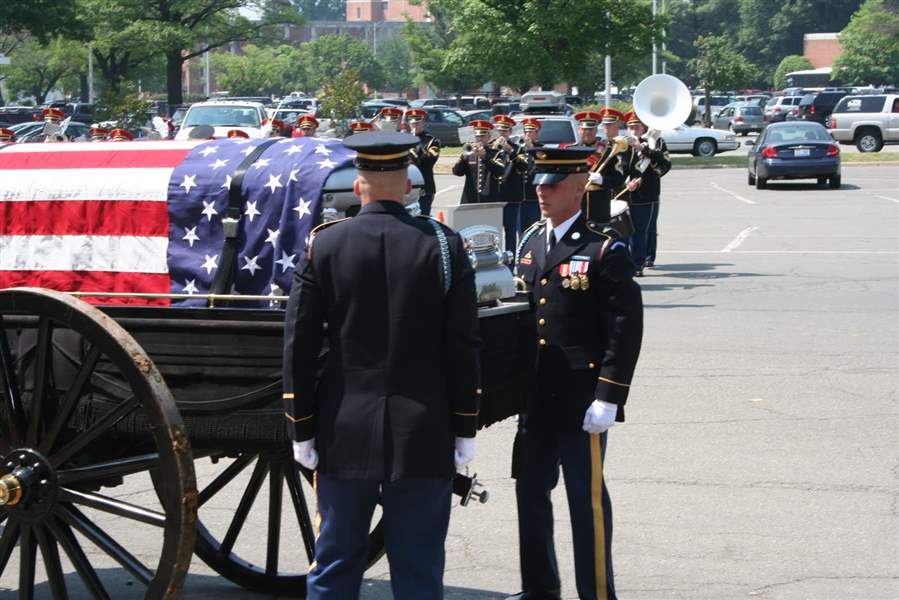
The honor guard follows a strict ritual steeped in respect.
SPECIAL TO THE BLADE/ RICH CRAWFORD
Buy This Image
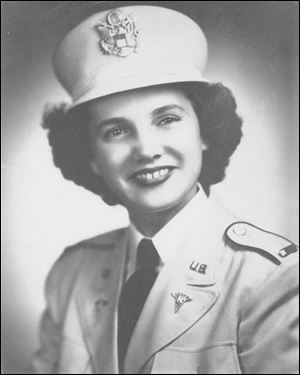
Helen L. Markey, U.S. Army, World War II.
ARLINGTON, Va. — Even the droplets of sweat tracing down the brow of each member of the honor guard seem to follow a strict cadence. When the U.S. military buries a soldier, the precision is stunning and the display of respect without equal.
At Arlington National Cemetery, they do this 25 to 30 times every day. In January and in August, in the rain, the snow, or the blistering humidity, they honor their fallen with a saturation of dignity.
One year ago, it was 95 degrees on Memorial Day weekend when we put First Lt. Helen Louise Markey to rest at that hallowed site.
Click here to view Toledo Magazine
This wasn’t someone who was part of the attack at Iwo Jima, or took a grenade to save their squad in Afghanistan. She never shouldered a rifle, raised a bayonet, or opened the bomb bay doors. Her service to this country was administered with tourniquets, transfusions, medicines, and compassion, but that mattered not.
On a make-you-melt kind of late May day in our nation’s capital, her escort platoon was locked in that posture that seems cut from steel. They stood rigid well before the Catholic memorial service for my mother concluded inside the chapel at Fort Myer, just beyond the gate to the cemetery.
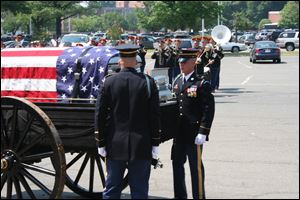
The honor guard follows a strict ritual steeped in respect.
In those crisp, dark, dress uniforms, snapped in perfect lines, there was a collection of young soldiers whose parents likely were not yet born when this Army nurse served, more than 65 years earlier. But they were there, with a colors team and a horse-drawn caisson, affording a woman who had passed away just a few months shy of her 90th birthday the same reverence you would expect to see for a fallen general or a battlefield hero.
As the procession threaded its way across the rolling expanse of 624 acres, just across the Potomac River from Washington, laborers, landscapers, military members, and civilians visiting gravesites all stopped. They turned and faced the caisson, hand over heart or right arm locked in a rigid salute.
All for a soldier they never knew.
A native of Moundsville, W.Va., She had enlisted in the Army at the start of World War II, not long out of nursing school, and was eventually sent to England aboard a hospital ship.
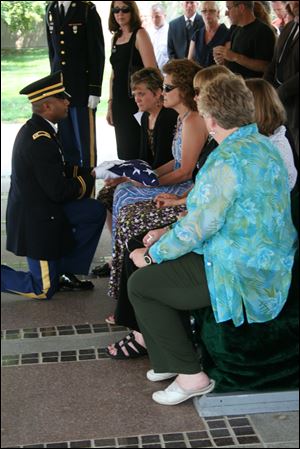
The Rev. John Baptist Gabriel, an Army captain, presents the ceremonial flag to the family.
Stationed first near Norwich, where the German bombings forced most into the shelters nearly every night, she was part of a large group of Army nurses transferred south early in 1944, where things took on an even more ominous tone. The nurses were schooled in the use of gas masks, how to treat victims of mustard gas attacks, and what to do if they were captured by the Nazis.
She had told us that when they heard the constant drone of planes going overhead one night, they knew it had to be D-Day. The next morning, the Army nurses piled into trucks and headed for an undisclosed location, very near the English Channel coast, where they set up a tent hospital.
Right away, the injured started coming in — American, British, and Canadian soldiers, and even German prisoners — all still in battle uniforms, many horribly wounded. She had recounted many years ago how most were treated and sent to a hospital in the interior of England, but some had died in her arms.
When the war ended, this nurse-soldier’s service was complete. She was part of that "Greatest Generation," which seemed like a clever alliterative tag when it first surfaced, but has since become a perfect label, and a reminder of our shortcomings.
As the caisson carrying her remains approached the Marshall Shelter at Arlington National Cemetery, the family formed a pretty sloppy formation by military standards, but we were all there — all 14 of her children, with their wives, husbands, and her grandchildren.
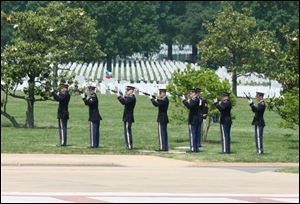
The 21-gun salute is performed as part of the burial ceremony at Arlington.
"Taps" was performed flawlessly and produced waves of chills, even on a sweltering day. The 21-gun salute then echoed across the grounds.
The Army gave my dad his final salute 15 years earlier, as he had served in World War II as well. The luck of the draw had him stationed in Greenland, far removed from the nightly bombardment and any live fire. When he started telling stories of his Army days, it was our duty to respectfully intercede and remind everyone that while dad was in the Army, mom was in the war.
And it was her commitment to serving her country that brought her to the decision decades ago that this would be her resting place. Her father had served in World War I, her two brothers in World War II, but she would represent the Matthews clan at Arlington.
After the honor guard snap-folded the flag that had been draped over the ceremonial casket and presented it to the family, a representative of the Department of Defense relayed the President’s gratitude for my mom’s service. The military escort snapped to attention and saluted First Lt. Helen Matthews Markey a final time.
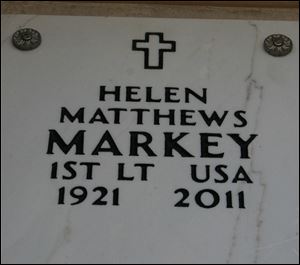
The stonemarker at the Arlington Columbarium.
Her cremated remains, tucked inside a decorative wooden jewelry box that had been hers since childhood, were placed in Court 8, Section UU, Column 1, Niche 6 of the Arlington Columbarium, near Patton Drive.
She was my mom a lot longer than she was in the Army, but they will watch over her now. Here, at Arlington National Cemetery, she’s one of the more than 330,000 they guard, each one of them a hero, and each with their own story.
Contact Blade outdoors editor Matt Markey at: mmarkey@theblade.com or 419-724-6068.